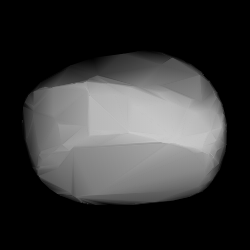Astronomy:3131 Mason-Dixon
 Mason-Dixon modeled from its lightcurve | |
| Discovery [1] | |
|---|---|
| Discovered by | E. Bowell |
| Discovery site | Anderson Mesa Stn. |
| Discovery date | 24 January 1982 |
| Designations | |
| (3131) Mason-Dixon | |
| Named after | Charles Mason [1] Jeremiah Dixon (English astronomers) |
| 1982 BM1 · 1962 CK 1975 XS2 · 1977 DB3 1979 OS16 · 1979 QJ6 A922 DC | |
| Minor planet category | main-belt [1][2] · (outer) Koronis [3][4][5] |
| Orbital characteristics [2] | |
| Epoch 27 April 2019 (JD 2458600.5) | |
| Uncertainty parameter 0 | |
| Observation arc | 63.82 yr (23,311 d) |
| |{{{apsis}}}|helion}} | 3.0505 AU |
| |{{{apsis}}}|helion}} | 2.7940 AU |
| 2.9222 AU | |
| Eccentricity | 0.0439 |
| Orbital period | 5.00 yr (1,825 d) |
| Mean anomaly | 118.17° |
| Mean motion | 0° 11m 50.28s / day |
| Inclination | 2.4041° |
| Longitude of ascending node | 44.734° |
| 147.18° | |
| Physical characteristics | |
| Mean diameter | 14 km (est. at 0.15)[6] |
| Rotation period | 19.748±0.0537 h[7][8] |
| Geometric albedo | 0.15 (family albedo)[9] |
| S (family based)[9] | |
| Absolute magnitude (H) | 12.0[1][2] |
3131 Mason–Dixon (prov. designation: 1982 BM1) is a Koronian asteroid from the outer regions of the asteroid belt. It was discovered on 24 January 1982, by American astronomer Edward Bowell at Lowell's Anderson Mesa Station in Arizona, United States.[1] The likely S-type asteroid has a rotation period of 19.7 hours and measures approximately 14 kilometers (9 miles) in diameter.[7] It was named for English astronomers Charles Mason and Jeremiah Dixon.[1]
Orbit and classification
Mason–Dixon is a core member of the Koronis family (605),[3][4][5] a very large asteroid family of almost 6,000 known asteroids with nearly co-planar ecliptical orbits.[9] It orbits the Sun in the outer main-belt at a distance of 2.8–3.1 AU once every 5 years (1,825 days; semi-major axis of 2.92 AU). Its orbit has an eccentricity of 0.04 and an inclination of 2° with respect to the ecliptic.[2]
The body was first observed at Heidelberg Observatory in February 1922. Its observation arc begins with a precovery taken at Palomar Observatory in July 1954.[1] On 1 February 1907, Mason–Dixon made a close approach to one of the larger asteroids, 52 Europa. At its closest, it passed Europa within 1.1 million kilometers.[citation needed]
Naming
This minor planet was named by the discoverer in memory of English astronomers Charles Mason (1728–1786) and Jeremiah Dixon (1733–1779), who observed the 1761 transit of Venus from the Cape of Good Hope. Between 1763 and 1767 they surveyed the so-called Mason–Dixon line, the boundary between the US States of Pennsylvania and Maryland. The official naming citation was published by the Minor Planet Center on 22 June 1986 (M.P.C. 10847).[10]
Physical characteristics
The asteroid's spectral type has not been determined.[3] Due its membership to the stony Koronis family, Mason–Dixon is likely a common S-type asteroid.[9]:23
Rotation period
In January 2012, a rotational lightcurve of Mason–Dixon was obtained from photometric observations by astronomers at the Palomar Transient Factory in California. Lightcurve analysis gave a rotation period of 19.748±0.0537 hours with a high brightness variation of 0.70 magnitude ({{{1}}}), indicative of an elongated, non-spherical shape.[8] Another fragmentary lightcurve by Maurice Clark at Preston Gott Observatory in September 2014 gave a less accurate period of 10.20 hours with an amplitude of 0.75 magnitude.[11]
Diameter and albedo
Assuming a typical albedo of 0.15 for members of the Koronis family,[9]:23 Mason–Dixon measures 14 kilometers based on an absolute magnitude of 12.00.[2][6] The Collaborative Asteroid Lightcurve Link assumes an albedo of a carbonaceous asteroid of 0.057 and consequently calculates a larger diameter of 18.6 kilometers.[7]
References
- ↑ 1.0 1.1 1.2 1.3 1.4 1.5 1.6 "3131 Mason-Dixon (1982 BM1)". Minor Planet Center. https://www.minorplanetcenter.net/db_search/show_object?object_id=3131.
- ↑ 2.0 2.1 2.2 2.3 2.4 "JPL Small-Body Database Browser: 3131 Mason-Dixon (1982 BM1)". Jet Propulsion Laboratory. https://ssd.jpl.nasa.gov/sbdb.cgi?sstr=2003131.
- ↑ 3.0 3.1 3.2 "Asteroid 3131 Mason-Dixon". Small Bodies Data Ferret. https://sbntools.psi.edu/ferret/SimpleSearch/results.action?targetName=3131+Mason-Dixon.
- ↑ 4.0 4.1 "Asteroid (3131) Mason-Dixon". AstDyS-2, Asteroids – Dynamic Site. https://newton.spacedys.com/astdys/index.php?n=3131&pc=1.1.6.
- ↑ 5.0 5.1 Zappalà, V.; Bendjoya, Ph.; Cellino, A.; Farinella, P.; Froeschle, C. (1997). "Asteroid Dynamical Families". NASA Planetary Data System: EAR-A-5-DDR-FAMILY-V4.1. https://sbnarchive.psi.edu/pds3/non_mission/EAR_A_5_DDR_FAMILY_V4_1/data/family.tab. Retrieved 4 March 2020.} (PDS main page)
- ↑ 6.0 6.1 "Asteroid Size Estimator". CNEOS NASA/JPL. https://cneos.jpl.nasa.gov/tools/ast_size_est.html.
- ↑ 7.0 7.1 7.2 "LCDB Data for (3131) Mason-Dixon". Asteroid Lightcurve Database (LCDB). http://www.minorplanet.info/PHP/generateOneAsteroidInfo.php?AstInfo=3131.
- ↑ 8.0 8.1 Waszczak, Adam; Chang, Chan-Kao; Ofek, Eran O.; Laher, Russ; Masci, Frank; Levitan, David et al. (September 2015). "Asteroid Light Curves from the Palomar Transient Factory Survey: Rotation Periods and Phase Functions from Sparse Photometry". The Astronomical Journal 150 (3): 35. doi:10.1088/0004-6256/150/3/75. Bibcode: 2015AJ....150...75W.
- ↑ 9.0 9.1 9.2 9.3 9.4 Nesvorný, D.; Broz, M.; Carruba, V. (December 2014). "Identification and Dynamical Properties of Asteroid Families". Asteroids IV. pp. 297–321. doi:10.2458/azu_uapress_9780816532131-ch016. ISBN 9780816532131. Bibcode: 2015aste.book..297N.
- ↑ "MPC/MPO/MPS Archive". Minor Planet Center. https://www.minorplanetcenter.net/iau/ECS/MPCArchive/MPCArchive_TBL.html.
- ↑ Clark, Maurice (July 2015). "Asteroid Photometry from the Preston Gott Observatory". The Minor Planet Bulletin 42 (3): 163–166. ISSN 1052-8091. Bibcode: 2015MPBu...42..163C.
External links
- Lightcurve Database Query (LCDB), at www.minorplanet.info
- Dictionary of Minor Planet Names, Google books
- Discovery Circumstances: Numbered Minor Planets (1)-(5000) – Minor Planet Center
- 3131 Mason-Dixon at AstDyS-2, Asteroids—Dynamic Site
- 3131 Mason-Dixon at the JPL Small-Body Database
 |


